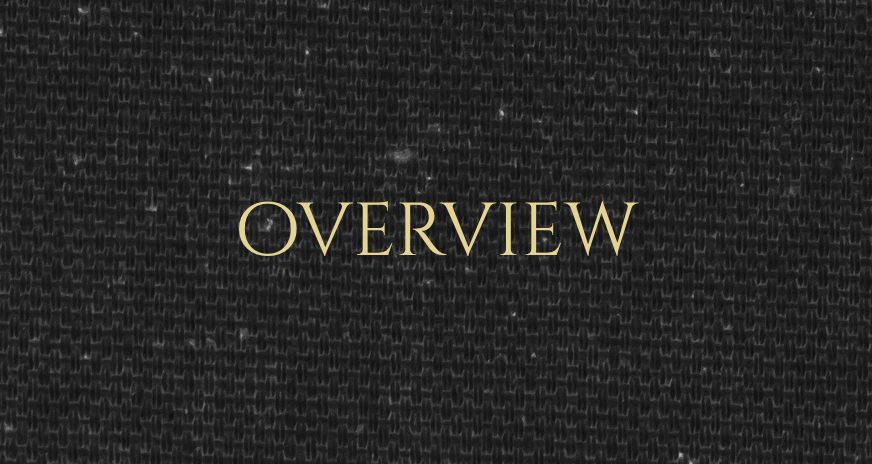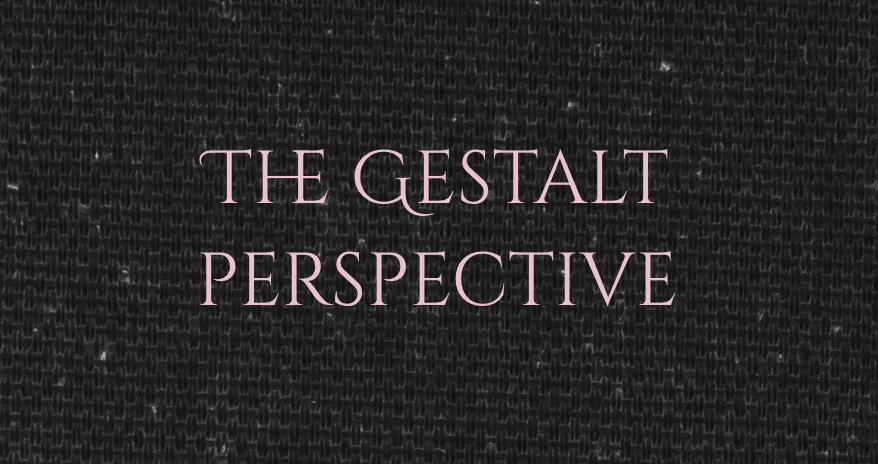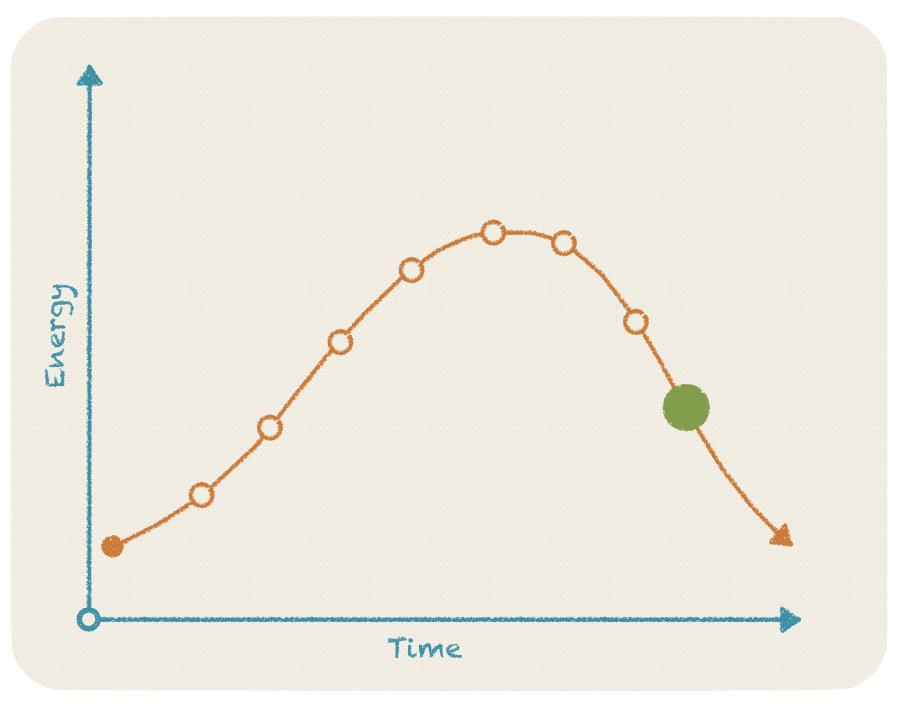The Gestalt Perspective
In Part I we have introduced the model of the Contact Cycle and shed some light on its relevance for practicing magicians. In this second part we will go into depth of explaining each of the eight stages of the model in detail. In addition to the description of each contact phase we will also draw on everyday examples to illustrate the often subconscious flow from one stage to the next.
Once we continue with Part III being aware of the different phases and how easily they can be missed or overlooked will be key to applying the model successfully in a context of Ritual Magic.
Here is a full overview of the model we will explore now:
Sensation
The initial energy level - and therefore the level of consciousness - of the first phase (Sensation) can be extremely low. After successfully completing a previous contact cycle our self is balanced and our awareness is in between distinct experiences. We might be busy with repetitive tasks or relaxing from an earlier encounter when suddenly we sense a disturbance. An internal or external disturbance comes into and starts to alter our current state of being. Much more than a concrete thought at this early stage it will be a direct sensual experience we encounter. Only then a thought starts to form and we become ready to notice, to become aware.
Examples: any physical sensations such as a slight pain in our stomach or behind our forehead, burning eyes, etc.
Symbolization
The nature of our mind is thus that it cannot perceive things without a shape (or Gestalt). Like the fingers of a blind our mind needs to veil perceptions into mental images, relate it to other things and previous experience and thus start to charge the sensual experience with symbolic or analogues meaning. Meister Eckhart’s famous words are a true depiction of these mental dynamics:
“When the soul wants to experience something she throws out an image in front of her and then steps into it.”
The previous stage of Sensation marked the initial flash of sensual realization; at this point everything is still a vital yet unbroken seed deep underground of our consciousness, a living carrier of possibilities hinting at similar experiences we might have made in the past. It is in this second stage of Symbolization that we cloth the sensual perception into the body or shape of an image. We identify our perception as a symbol of similar experiences in the past and what we see, hear, touch, taste or smell forms into the key to a door.
Examples: any attribution or symbolization that happens immediately and often unconsciously after realization of the sensual impulse, e.g. the craving for food on realizing a pain in the stomach, the fear of a headache after realizing a slight pain behind our forehead, the desire for a coffee when becoming aware of our burning eyes...
Mobilization
The next stage is the inevitable reaction to turning the key around - we open the door and unleash related emotional energies and mental images. This third stage is called Mobilization as at this point we see a sudden increase in our overall energy level. What had been smoldering before lights up into a clear and present flame. Our mind and body are mobilized by the energy that rushes through our muscle tone, our blood and mind.
Example: the attribution or symbolization created during the previous step unfolds its energy within us, e.g. increasing saliva in our mouth and while realizing the pain in the stomach more clearly, taking a deep breath and starting to massage our forehead, rubbing our eyes, etc...
Action
We are now activated and what used to be a disturbance has transformed into an impulse to act. We start to consider, chose and reject possibilities. We search for behaviors that have proven to be relevant in past situations of similar needs. In split seconds we flip through the catalogue of available behaviors we have acquired and learned over our lifetime. We might chose one of the behavioral index cards or we might rely on our intuition and create a new and so far unknown reaction. We innovate.
Example: any action that we take originally triggered by the first sensual impression or its later symbolization e.g. getting up and walking to the fridge, drinking a large glass of water or finishing work early to relax, going through all physical steps necessary to get a fresh coffee or going to bed early.
Contact
Having healthily mobilized and acted we encounter full and vibrant contact. We are both witness to and actor in the dialogue we are co-creating. All other perceptions have faded into the background and we are fully present to engage in contact with the ‘Gestalt’ in front of us. Change takes place and involves us fully. This is the moment of risk and surprise: Our symbolization might have been faulty, we might have assigned meaning to the initial impulse that wasn’t in line with it’s nature. We might have projected unsatisfied needs onto the heralding encounter. We might see the ‘key’ transform in our hands and unlock a door we wanted to keep shut... Or no door is opened at all and we - ready and expectantly waiting for a rush of energy in full contact - might let go of the contact, allow it to fade out from our center to the boundaries of our self and sink into frustration...
Example: any experience of direct encounter that is triggered by our actions, e.g. the joyful feeling of fresh food in our mouth and the pleasure as our growling stomach comes to rest - or - the increasing pain in our stomach as we eat, indicating we mis-attributed the pain to hunger instead of illness.
Satisfaction
While in contact all things are possible. No preparation is perfect and life is full of risks. Simultaneously a life of continuos full contact won’t allow us to perceive things that have faded into the background. Inevitably we will lose perspective and start living in a narrow field of vision. Everything yet uncreated, all things unrelated to our current state of being will vanish until nothing new and surprising can emerge from the background anymore. This is why letting go is just as important as being able to fully engage in contact. The ability to realize satisfaction, to be in touch with our ever evolving, ever changing inner needs is a rare skill among us.
Example: any new physical sensation indicating a state of satisfaction related to the our previous action, e.g. after our growling stomach has come to rest we begin to sense a feeling of satiety; after we have drunken a glass of water and rested on a park bench for a while we feel relieved, somewhat tired yet also refreshed; after we drank the fresh coffee we its taste still fills our mouth and our eyes feel less tired.
Integration
Once we realize satisfaction we bring the contact to an end. We disengage and withdraw from the encounter into our self. While contact can involve our full self it takes place at the boundary of our self (i.e. Gestalt). We now return to our own centre and start to integrate the experience made. How does it relate to similar earlier experiences? Did we encounter reassurance or confusion of existing beliefs? Was our life enriched or repeated? What is the echo and the aftertaste within us?
This phase could be called many names for there are many symbols for this often unconscious process: assimilation, digestion, reverberation, balancing or interpretation. In any case it is the mirror phase to Symbolization in every Contact Cycle. While in the first we draw on existing resources and experiences, in the latter we update and align our inner archives according to the ‘new material’ we encountered.
Example: any internal confirmation, innovation or learning that is realized after contact has ended, e.g. we consider the option of having breakfast again as this was the third time this week we had stomach pains before lunch time; we feel reassured about our coping mechanism to visit the local park bench whenever we feel overworked and need a short time-out; we ponder if we should try to get more sleep as this was the third coffee we had this morning...
Withdrawal
During the last phase of the Contact Cycle we end all direct or conscious engagement with the contact we experienced. While echoes of the dialogue we have been involved in might still resound through our subconsciousness we withdraw from the situation consciously. Often this state of the Contact Cycle is overlooked. Yet it forms an essential part of every full encounter: the return into a state of balance and non-contact. A state of inner freedom and non-engagement. We are present yet no new gestalt has emerged into the foreground yet. All possibilities are quietly waiting in the background.
Example: any experience that is neither related to the previous contact nor yet starting to create a new conscious contact cycle; we box leftovers from our lunch and store them in the fridge while not thinking about lunch anymore; we walk back to the office from the park bench while not thinking about work yet; we leave the coffee place and step out into the noise of the street...
Selected Resources
- Buber, Martin, Ich und Du, 1923 (1919)
- Forrest, David, http://www.gestaltuk.com/indepth/contact-cycle
- Hartmann-Kottek, Lotte, Gestalttherapie, Springer Verlag 2008
- Perls, Fritz, Ego, Hunger and Aggression: A Revision of Freud's Theory and Method, 1942
- Zinker, Joseph, Creative Process in Gestalt Therapy, Vintage 1978















